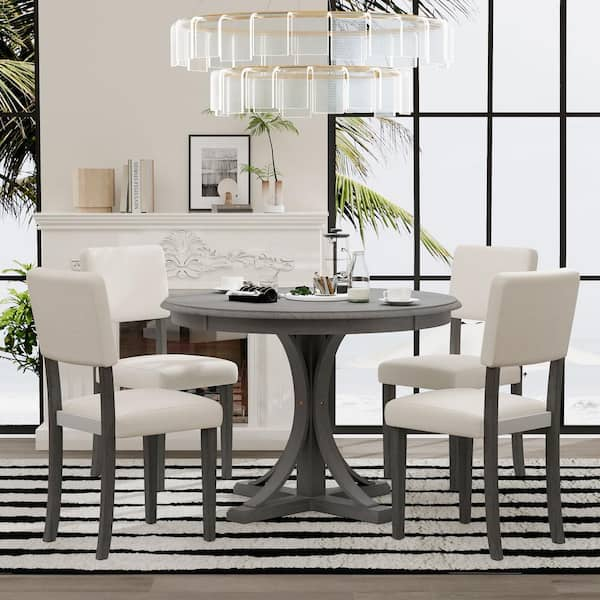Transform Your Dining Space with Stylish Dining Room Table Legs
Transform Your Dining Space with Stylish Dining Room Table Legs
Blog Article
From Standard to Modern: Locate the Perfect Dining-room Table Legs for Your Style
While traditional layouts such as cabriole and turned legs evoke a feeling of ageless elegance, modern designs like hairpin and geometric options offer a chance for striking aesthetic interest. As you consider these aspects, the inquiry stays: just how can you seamlessly integrate these diverse leg designs to develop a harmonious dining experience?
Comprehending Table Leg Styles
The range of eating area table leg designs can dramatically affect both the visual appeals and performance of the area. Each leg style adds one-of-a-kind practical functions and visual elements, accommodating diverse design preferences and usage requirements. Recognizing these designs is critical for selecting the best dining table that straightens with your total interior decoration vision.
For circumstances, conical legs use a clean, classic look that can enhance an area's style, while stand bases offer stability and optimize legroom, making them suitable for smaller spaces. Barrette legs, a characteristic of mid-century modern-day design, present a commercial flair, permitting an airy, open feeling. Trestle legs stimulate rustic beauty, giving robust assistance and a sense of eternity.
Wood legs can bring warmth and texture, whereas steel alternatives commonly convey a streamlined, contemporary vibe. Inevitably, understanding table leg styles is crucial for creating a cohesive eating location that shows personal style while making sure usefulness and comfort.
Standard Table Leg Options
When selecting dining space table legs, typical options often personify classic elegance and craftsmanship. These styles show a rich heritage and a commitment to high quality, making them perfect for those that appreciate timeless aesthetic appeals.
Among one of the most legendary traditional leg styles is the cabriole leg, defined by its stylish rounded form. This design commonly includes attractive makings and is most generally discovered in Queen Anne and Chippendale furnishings. An additional preferred alternative is the transformed leg, which flaunts a collection of smooth, rounded forms that supply a classic look while keeping security.
In addition, the straight leg, while straightforward, offers a basic and strong framework that can blend perfectly with a selection of tabletop designs. For those attracted to ornate outlining, claw-and-ball feet legs evoke a sense of majesty and can function as a stunning prime focus in any eating space.
Last but not least, stand bases, although not strictly legs, offer an alternative typical option that enables for sufficient legroom and can be beautifully sculpted. Each of these conventional leg styles contributes to the total atmosphere of a dining-room, weding function with aesthetic allure.

Modern Table Leg Styles
Modern table leg layouts use a diverse array of styles that stress clean lines and cutting-edge materials. These designs often prioritize functionality while acting as striking focal factors within a dining area. Minimal looks are prevalent, with legs crafted from products such as steel, glass, and engineered wood, which add to a modern and airy feeling.
One popular style is the hairpin leg, characterized by its slender, conical structure that offers stability without overwhelming the tabletop (dining room table legs). This design is frequently discovered in mid-century modern-day furnishings and can effortlessly match numerous dining table shapes. An additional trend is making use of geometric forms, where legs may handle unbalanced or angular kinds, adding aesthetic passion and a touch of artistry

Blending Designs for Special Areas
Commonly, house owners seek to create special eating areas that show their personal design by mixing different layout elements. This method permits for the consolidation of diverse aesthetic appeals, leading to a harmonious yet distinctive setting. Matching a rustic wooden table with streamlined, modern steel legs can produce an attractive comparison that raises the room's total allure.
Furthermore, integrating vintage table legs with modern tabletops can stimulate a sense of history while keeping a contemporary sensibility. Such mixes not just you can check here showcase specific preference but additionally encourage creative thinking, enabling home owners to curate a room that feels both individual and inviting.
Shade plays an important function in this blending procedure; selecting table legs that enhance or contrast with the existing color pattern can boost aesthetic rate of interest. Whitewashed legs can soften the daring of a dark table surface, creating a well balanced aesthetic.
Tips for Picking the Right Legs
Selecting the right table legs is crucial for achieving both capability and aesthetic charm in your eating space. Begin by thinking about the total style of your space. Traditional settings gain from legs that include intricate carvings or turned styles, while modern rooms may require smooth, minimal styles.
Following, analyze the height and stability of the legs. dining room table legs. Typical table range between 28 to More Bonuses 30 inches in height, so make sure the legs enhance this measurement for comfort. Furthermore, durable products, such as wood or steel, can enhance stability and durability
Review the leg form too-- alternatives include directly, tapered, or stand layouts. Straight legs supply a timeless appearance, while conical legs can include a touch of elegance. Pedestal bases offer sufficient legroom and are suitable for smaller sized areas.
Final Thought
In summary, selecting the ideal eating room table legs calls for cautious factor to consider of both traditional and modern-day designs. By balancing leg style, elevation, and material with the total design, a cohesive and welcoming environment can be attained.
The range of eating space table leg designs can substantially influence both the aesthetic appeals and performance of the room. Eventually, recognizing table leg styles is essential for producing a natural dining area that mirrors personal design while ensuring usefulness Full Report and comfort.One of the most legendary conventional leg designs is the cabriole leg, characterized by its stylish rounded form. Straight legs offer a traditional appearance, while tapered legs can add a touch of elegance.In recap, picking the optimal eating room table legs needs mindful factor to consider of both modern and standard designs.
Report this page